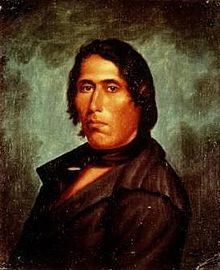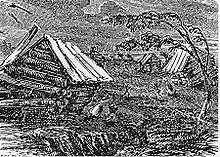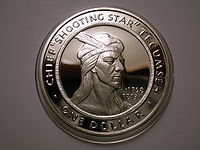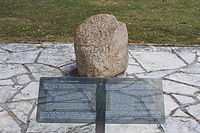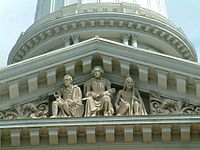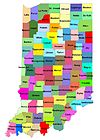- Tecumseh
-
For other uses, see Tecumseh (disambiguation).
Tecumseh 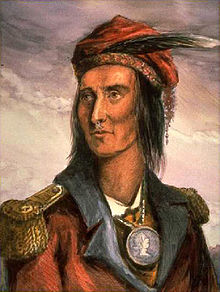
A depiction of Tecumseh from c. 1868Born March, 1768
On the Scioto River, near Chillicothe, Ohio
(location uncertain, see Early life)Died October 5, 1813 (aged 45)
Moravian of the Thames
(near modern Chatham-Kent, Ontario)Nationality Shawnee Other names Tecumtha, Tekamthi Known for War of 1812 Parents Puckshinwa, Methoataske Tecumseh (March 1768 – October 5, 1813) was a Native American leader of the Shawnee and a large tribal confederacy (known as Tecumseh's Confederacy) which opposed the United States during Tecumseh's War and the War of 1812. Tecumseh has become an icon and heroic figure in American Indian and Canadian history.
Tecumseh grew up in the Ohio Country during the American Revolutionary War and the Northwest Indian War, where he was constantly exposed to warfare.[1] With Americans continuing to encroach on Indian territory after the British ceded the Ohio Valley to the new United States in 1783, the Shawnee moved further northwest. In 1808, they settled Prophetstown in present-day Indiana. With a vision of establishing an independent American Indian nation east of the Mississippi, Tecumseh worked to recruit additional tribes to the confederacy from the southern United States.[1]
During the War of 1812, Tecumseh's confederacy allied with the British in The Canadas (the collective name for the colonies of Upper Canada and Lower Canada), and helped in the capture of Fort Detroit. Tecumseh was killed in the Battle of the Thames, in October 1813.
Contents
Family background
Tecumseh's father was Puckshinwa (in Shawnee, Puckeshinwau, meaning "Alights from Flying", "Something that drops" or "I light from flying", also known as Puckeshinwa, Pucksinwah, Pukshinwa, Pukeesheno, Pekishinoah, Pooksehnwe and other variations), a minor Shawnee war chief of the Kispoko ("Dancing Tail" or "Panther") band and the Panther Clan of the tribe. Puckshinwa's father was Muscogee (Creek) and his mother was Shawnee. Either because his father died when he was young or because among the Creeks a husband lives with his wife's family, Puckshinwa was considered a Shawnee.[2][3]
Tecumseh's mother was Methotaske (in Shawnee, Methoataaskee, meaning "[One who] Lays Eggs in the Sand" or "A turtle laying eggs in the sand", also known as Methoataske, Meetheetashe, Methotase and Methoatase), Puckshinwa's second wife. She is believed to have been Shawnee through her father and her mother, possibly of the Pekowi band and the Turtle Clan. Some traditions hold that she was Creek, because she had lived among that tribe prior to marriage; some hold that she was Cherokee, having died in old age living among that tribe; still others hold that she was a white captive, as family stories claim that Puckshinwa had been married to a white captive.[2][4]
Shawnee lineage was recorded paternally, which made Tecumseh a member of the Kispoko.
At the time Tecumseh's parents married, their tribe was living somewhere near modern Tuscaloosa, Alabama. They had lived in that region alongside the Creek tribe since being driven from their homes in the Ohio River Valley by the Iroquois (based in New York and Pennsylvania) during the 17th-century Beaver Wars.[5]
About 1759, the Pekowi band decided to move west into the Ohio Country. Not wanting to force his wife to choose between him and her family, Puckshinwa decided to travel north with her. The Pekowi founded the settlement of Chillicothe where Tecumseh was likely born. During the 1760s, Puckshinwa took part in the French and Indian War.
Early life
Tecumseh (in Shawnee, Tekoomsē, meaning "Shooting Star" or "Panther Across The Sky", also known as Tecumtha or Tekamthi) was born about March 1768. His birthplace, according to popular tradition, was Old Chillicothe[6] (the present-day Oldtown area of Xenia Township, Greene County, Ohio, about 12 miles (19 km) east of Dayton). As Old Chillicothe was not settled by the Shawnee until 1774, it is believed that Tecumseh may have been born in a different "Chillicothe" (in Shawnee, Chalahgawtha), which was the tribe's name for its principal village, wherever it was located. Tecumseh is believed to have been born in a Chillicothe along the Scioto River, near the present-day city of Chillicothe, Ohio.
“ As Pucksinwah stared at the sky on this night, he saw a huge meteor streak across from the north, leaving a trail of greenish-white flame. It lasted for fully 20 seconds and was unlike anything he had ever seen before. This was the Panther spirit that the old men sometimes spoke of, and a good sign indeed. As the women around the fire talked excitedly and pointed to the heavens, a baby's cry came from the shelter. Usually a child was not named for several days while the parents waited for a sign to indicate what the great spirit Moneto wished the child to be called, but this child must surely be named Tecumseh, "The Panther Passing Across". ” —- Tecumseh: Xenia Township's Most Famous Native, Alan King, 2000
Not long after Tecumseh's birth, the family moved to the village of Scioto.
When Tecumseh was a boy, his father Puckshinwa was "brutally murdered" by white frontiersmen who had crossed onto Indian land in violation of a recent treaty, at the Battle of Point Pleasant during Lord Dunmore’s War in 1774. Tecumseh resolved to become a warrior like his father and to be "a fire spreading over the hill and valley, consuming the race of dark souls."[7][8]
At age 15, after the American Revolutionary War, Tecumseh joined a band of Shawnee who were determined to stop the white invasion of their lands by attacking settlers' flatboats traveling down the Ohio River from Pennsylvania. In time, Tecumseh became the leader of his own band of warriors. For a while, these Indian raids were so effective that river traffic virtually ceased.[8]
Frontier conflicts
At least five times between 1774 and 1782, Tecumseh's village was attacked by colonials and later American armies, as the Shawnee had allied with the British during the American Revolutionary War. Following his father's death, his family moved back to Chief Blackfish's nearby village of Chillicothe. The town was destroyed in 1779 by Kentucky militia in reprisal for Blackfish's attack on Boonesburough.[9] His family fled to another nearby Kispoko village, but this was destroyed in 1780 by forces under the command of George Rogers Clark. The family moved a third time to the village of Sanding Stone. That village was attacked by Clark in November of 1782, and the family moved to a new Shawnee settlement near modern Bellefontaine, Ohio.[10]
Violence continued on the American frontier after the Revolution as the Northwest Indian War. A large tribal confederacy, known as the Wabash Confederacy, which included all the major tribes of Ohio and the Illinois Country, formed to repel the American settlers from the region.[11] As the war between the confederacy and the Americans grew, Tecumseh became a warrior and took an active part fighting along with his older brother Cheeseekau, an important war leader who essentially raised Tecumseh and Tenskwatawa after their parents' early deaths. Their older sister, Tecumapese, was also very important to their upbringing.
In early 1789, Tecumseh traveled south with Cheeseekau to live among, and fight alongside, the Chickamauga faction of the Cherokee. Accompanied by twelve Shawnee warriors, they stayed at Running Water (in Marion County, Tennessee), where Cheeseekau's wife and daughter lived. There Tecumseh met Dragging Canoe, a famous leader who was leading a resistance movement against U.S. expansion. Cheeseekau was killed while leading a raid, and Tecumseh assumed leadership of the small Shawnee band, and subsequent Chickamauga raiding parties.
Tecumseh returned to Ohio in late 1790, having fathered a Cherokee daughter before leaving (according to Cherokee oral tradition).[citation needed] Afterward, Tecumseh took part in several battles, including that of the 1794 Fallen Timbers. The Indians were defeated by the Americans, which ended the Northwestern Indian Wars in favor of the Americans.[12]
Tenskwatawa
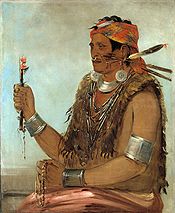 Tenskwatawa, by George Catlin.
Tenskwatawa, by George Catlin.
Tecumseh eventually settled in what is now Greenville, Ohio, the home of his younger brother, Lalawethika ("He Makes A Loud Noise") who would later take the new name of Tenskwatawa ("The Open Door"). After difficult years as a young man who suffered from alcoholism, Tenskwatawa became a religious leader. Known as "The Shawnee Prophet", he advocated a return of the Shawnee and other American Indians to their ancestral lifestyle and rejection of the colonists and Americans. He attracted a large following among Indians who had already suffered major epidemics and dispossession of their lands.
In 1805, Tenskwatawa led a religious revival following a series of witch-hunts following an outbreak of smallpox among the Shawnee. His beliefs were based on the earlier teachings of the Lenape prophets, Scattamek and Neolin, who predicted a coming apocalypse that would destroy the European-American settlers.[13]
Tenskwatawa urged natives to reject the ways of the Europeans: to give up firearms, liquor, European style clothing, to pay traders only half the value of their debts, and to refrain from ceding any more lands to the United States. The teachings led to rising tensions between the settlers and his followers. Opposing Tenskwatawa was the Shawnee leader Black Hoof, who was working to maintain a peaceful relationship with the United States.[13]
The earliest record of Tecumseh's interaction with the Americans was in 1807, when the US Indian agent William Wells met with Blue Jacket and other Shawnee leaders in Greenville to determine their intentions after the recent murder of a settler. Tecumseh was among those who spoke with Wells and assured him that his band of Shawnee intended to remain at peace and wanted only to follow the will of the Great Spirit and his prophet. According to Well's report, Tecumseh told him that the Prophet intended to move with his followers deeper into the frontier and away from American settlements.[14]
By 1808, due to increasing tensions with the encroaching settlers, Black Hoof demanded that Tenskwatawa and his followers leave the area. Tecumseh was among the leaders of the group, and helped decide to move further northwest and establish the village of Prophetstown near the confluence of the Wabash and Tippecanoe rivers (near present-day Battle Ground, Indiana). The site was in Miami tribe territory, and their Chief Little Turtle warned the group not to settle there. Despite the threat, the Shawnee moved into the region and the Miami left them alone. According to his brother's later account, Tecumseh was already contemplating a pan-tribal confederacy to counter American expansion into Indian-held lands. He was considered a natural and charismatic leader.[15]
Tenskwatawa's religious teachings became more widely known, as did his predictions on the coming doom of the Americans. His teachings attracted numerous members of other tribes to Prophetstown; they formed the basis of a sizeable confederacy of tribes in the southwestern Great Lakes region. Tecumseh emerged as the primary leader of this confederation, although it had started with warriors attracted by the religious appeal of his younger brother. Relatively few in confederacy were Shawnee; the confederacy was made up primarily of other tribes.[13][16]
Tecumseh's War
Main article: Tecumseh's War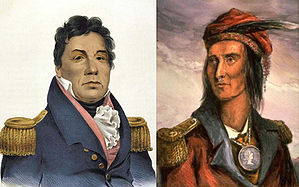
Portraits of Pushmataha (left) and Tecumseh.
Pushmataha, 1811[17]
--------------------- "Where today are the Pequot? Where are the Narragansett, the Mochican, the Pocanet, and other powerful tribes of our people? They have vanished before the avarice and oppression of the white man ... Sleep not longer, O Choctaws and Chickasaws ... Will not the bones of our dead be plowed up, and their graves turned into plowed fields?"
Tecumseh, 1811[18]The two principal adversaries in the conflict, Tecumseh and William Henry Harrison, had both been junior participants in the Battle of Fallen Timbers at the close of the Northwest Indian War in 1794. Tecumseh was not among the signers of the Treaty of Greenville that had ended the war and ceded much of present-day Ohio, long inhabited by the Shawnee and other Native Americans, to the United States. However, many Indian leaders in the region accepted the Greenville terms, and for the next ten years pan-tribal resistance to American hegemony faded.
After the Treaty of Greenville, most of the Ohio Shawnee settled at the Shawnee village of Wapakoneta on the Auglaize River, where they were led by Black Hoof, a senior chief who had signed the treaty. Little Turtle, a War Chief of the Miamis, who had also participated in the earlier war and signed the Greenville Treaty, lived in his village on the Eel River. Both Black Hoof and Little Turtle urged cultural adaptation and accommodation with the United States.
The tribes of the region participated in several treaties including the Treaty of Grouseland and the Treaty of Vincennes that gave and recognized American possession of most of southern Indiana. The treaties resulted in an easing of tensions by allowing settlers into Indiana and appeasing the Indians with reimbursement for the lands the settlers were squatting on.
Rising tensions
In September 1809, William Henry Harrison, governor of the newly formed Indiana Territory, negotiated the Treaty of Fort Wayne in which a delegation of Indians ceded 3 million acres (12,000 km2) of Native American lands to the United States. The treaty negotiations were questionable as they were unauthorized by the President and thus the United States government, and involved what some historians compared to bribery, offering large subsidies to the tribes and their chiefs, and the liberal distribution of liquor before the negotiations.[19]
Tecumseh's opposition to the treaty marked his emergence as a prominent leader. Although Tecumseh and the Shawnee had no claim on the land sold, he was alarmed by the massive sale as many of the followers in Prophetstown were Piankeshaw, Kickapoo, and Wea, who were the primary inhabitants of the land. Tecumseh revived an idea advocated in previous years by the Shawnee leader Blue Jacket and the Mohawk leader Joseph Brant, which stated that Indian land was owned in common by all.[20]
Not ready to confront the United States directly, Tecumseh's primary adversaries were initially the Indian leaders who had signed the treaty. An impressive orator, Tecumseh began to travel widely, urging warriors to abandon accommodationist chiefs and to join him in resistance of the treaty.[21] Tecumseh insisted that the Fort Wayne treaty was illegal; he asked Harrison to nullify it, and warned that Americans should not attempt to settle on the lands sold in the treaty. Tecumseh is quoted as saying, "No tribe has the right to sell [land], even to each other, much less to strangers.... Sell a country!? Why not sell the air, the great sea, as well as the earth? Didn't the Great Spirit make them all for the use of his children?" And, "....the only way to stop this evil [loss of land] is for the red man to unite in claiming a common and equal right in the land, as it was first, and should be now, for it was never divided."[22]:
Confrontation
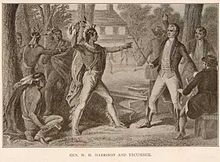 At Vincennes in 1810, Tecumseh loses his temper when William Henry Harrison refuses to rescind the Treaty of Fort Wayne.
At Vincennes in 1810, Tecumseh loses his temper when William Henry Harrison refuses to rescind the Treaty of Fort Wayne.
Tecumseh met with Indiana Governor William Henry Harrison to demand the rescission of land purchase treaties the US had forced on the Shawnee and other tribes. Harrison refused.
In August 1810, Tecumseh led four hundred armed warriors from Prophetstown to confront Harrison at his Vincennes home, Grouseland. Their appearance startled the townspeople, and the situation quickly became dangerous when Harrison rejected Tecumseh's demand and argued that individual tribes could have relations with the United States, and that Tecumseh's interference was unwelcome by the tribes of the area. Tecumseh launched an impassioned rebuttal against Harrison.[23]
(Governor William Harrison), you have the liberty to return to your own country ... you wish to prevent the Indians from doing as we wish them, to unite and let them consider their lands as common property of the whole ... You never see an Indian endeavor to make the white people do this ... Sell a country! Why not sell the air, the great sea, as well as the earth? Did not the Great Spirit make them all for the use of his children? How can we have confidence in the white people?[24]
Tecumseh began inciting the warriors to kill Harrison, who responded by pulling his sword. The small garrison defending the town quickly moved to protect Harrison. Pottowatomie Chief Winnemac arose and countered Tecumseh's arguments to the group, and urged the warriors to leave in peace. As they left, Tecumseh informed Harrison that unless he rescinded the treaty, he would seek an alliance with the British.[25]
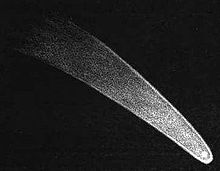 The Great Comet of 1811, as drawn by William Henry Smyth
The Great Comet of 1811, as drawn by William Henry Smyth
A comet appeared in March 1811. The Shawnee leader Tecumseh, whose name meant "shooting star", told the Creeks that the comet signaled his coming. Tecumseh's confederacy and allies took it as an omen of good luck. McKenney reported that Tecumseh claimed he would prove that the Great Spirit had sent him to the Creeks by giving the tribes a "sign."
In 1811, Tecumseh again met with Harrison at his home after being summoned following the murder of settlers on the frontier. Tecumseh told Harrison that the Shawnee and their Native American brothers wanted to remain at peace with the United States, but these differences had to be resolved. The meeting was likely a ploy to buy time while he built a stronger confederacy, and the meeting convinced Harrison that hostilities were imminent. Following the meeting Tecumseh traveled south, on a mission to recruit allies among the Five Civilized Tribes. Most of the southern nations rejected his appeals, but a faction among the Creeks, who came to be known as the Red Sticks, answered his call to arms, leading to the Creek War.[25]
Where today are the Pequot? Where are the Narragansett, the Mochican, the Pocanet, and other powerful tribes of our people? They have vanished before the avarice and oppression of the white man, as snow before the summer sun ... Sleep not longer, O Choctaws and Chickasaws ... Will not the bones of our dead be plowed up, and their graves turned into plowed fields?[18]
Tippecanoe
Main article: Battle of TippecanoeWhile Tecumseh was in the South, Governor Harrison marched up the Wabash River from Vincennes, with more than 1,000 men, on a preemptive expedition to intimidate the Prophet and his followers and to force them to make peace. On November 6, 1811, Harrison's army arrived outside Prophetstown. The Prophet sent a messenger to meet with Harrison and requested a meeting be held the next day to negotiate. Harrison encamped his army on a nearby hill, and during the early dawn hours of November 7, the confederacy launched a sneak attack on his camp. In the Battle of Tippecanoe, Harrison's men held their ground, and the Indians withdrew from the village after the battle. The victorious Americans burned the town and returned to Vincennes.[26]
The Battle of Tippecanoe was a severe blow for Tenskwatawa, who lost both prestige and the confidence of his brother. Although it was a significant setback, Tecumseh began to secretly rebuild his alliance upon his return. The Americans soon after went to war with the British in the War of 1812, and Tecumseh's War became a part of that struggle.[26]
On December 11, 1811, the New Madrid Earthquake shook the South and the Midwest. While the interpretation of this event varied from tribe to tribe, one consensus was universally accepted: the powerful earthquake had to have meant something. For many tribes it meant that Tecumseh and the Prophet must be supported.[27]
War of 1812
Detroit frontier
See also: Siege of DetroitTecumseh rallied his confederacy and led his forces to join the British army invading the northwest from Upper Canada. Tecumseh joined British Major-General Sir Isaac Brock in the Siege of Detroit, and forced the city's surrender in August 1812. As Brock advanced to a point just out of range of Detroit's guns, Tecumseh had his approximately four hundred warriors parade out from a nearby wood and circle back around to repeat the maneuver, making it appear that there were many more warriors than was actually the case. The fort commander, Brigadier General William Hull, surrendered in fear of a massacre should he refuse. The victory was of a great strategic value to the British allies.[28]
This victory was reversed a little over a year later. Commodore Oliver Hazard Perry's victory on Lake Erie late in the summer of 1813 cut the British supply lines. Along with William Henry Harrison's successful defense of Fort Miegs (creating a staging area for the recapture of Fort Detroit), the British found themselves in an indefensible position and had to withdraw from the city. They burned all public buildings in Detroit and retreated into Upper Canada along the Thames Valley. Tecumseh sought British support for continuing to defend their lands against the Americans. However, Harrison led a much larger counter assault and invaded Canada. The British retreated before his forces, but Tecumseh and the outnumbered Shawnee Confederacy fought on.
Battle of the Thames
The next British commander, Major-General Henry Procter, did not have the same working relationship with Tecumseh as his predecessor and the two disagreed over tactics. Procter favored withdrawing into Canada and avoiding battle while the Americans suffered from the winter. Tecumseh was more eager to launch a decisive action to defeat the American army and allow his men to retake their homes in the northwest.[29] Procter failed to appear at Chatham, Ontario, though he had promised Tecumseh that he would make a stand against the Americans there. Tecumseh moved his men to meet Proctor again and informed him that he would withdraw no farther, and if the British wanted his continued help then an action needed to be fought. Harrison crossed into Upper Canada and on October 5, 1813, won a victory over the British and Native Americans at the Battle of the Thames (near Moraviantown). Tecumseh was killed, and shortly after the battle, the tribes of his confederacy surrendered to Harrison at Detroit.[30] In 1836 and 1837, in part because of reports that it was he who had killed Tecumseh, Richard Mentor Johnson was elected vice-president of the United States, to serve with Martin Van Buren.
Legacy
Memorials
"Tecumseh Stone", Fort Malden National Historic Site
The United States Naval Academy in Annapolis, Maryland, has Tecumseh Court, which is located outside Bancroft Hall's front entrance, and features a bust of Tecumseh. The bust is often decorated to celebrate special days. The bust was actually originally meant to represent Tamanend, an Indian chief from the 17th century who was known as a lover of peace and friendship, but the Academy's midshipmen preferred the more warlike Tecumseh, and the new name persisted.[31]
Four ships of the United States Navy have borne the name USS Tecumseh.
- The first USS Tecumseh (1863), was a Canonicus-class monitor, commissioned on 19 April 1864. It was lost with almost all hands on 5 August, at the Battle of Mobile Bay.
- The second tugboat, originally named Edward Luckenbach, purchased by the Navy in 1898 and renamed. She served off and on until she was struck from the Navy list ca. 1945.
- The third ballistic missile submarine, commissioned in 1964 and struck in 1993.
The Canadian naval reserve unit HMCS Tecumseh is based in Calgary, Alberta. Tecumseh is honored in Canada as a hero and military commander who played a major role in Canada's successful repulsion of an American invasion in the War of 1812, which, among other things, eventually led to Canada's nationhood in 1867 with the British North America Act. Among the tributes, Tecumseh is ranked 37th in The Greatest Canadian list. An 1848 drawing of Tecumseh was based on a sketch done from life in 1808. Benson Lossing altered the original by putting Tecumseh in a British uniform, under the mistaken (but widespread) belief that Tecumseh had been a British general. This depiction is unusual in that it includes a nose ring, popular among the Shawnee at the time, but typically omitted in idealized depictions.
He is also honored by a massive portrait which hangs in the Royal Canadian Military Institute. The unveiling of the work, commissioned under the patronage of Kathryn Langley Hope and Trisha Langley, took place at the Toronto-based RCMI on October 29, 2008.[citation needed]
A number of towns have been named in honor of Tecumseh, including those in the states of Kansas, Michigan, Missouri, Nebraska, Oklahoma, and the province of Ontario, as well as the town and township of New Tecumseth, Ontario, and Mount Tecumseh in New Hampshire. Union Civil War general William Tecumseh Sherman, was given the name Tecumseh because "my father...had caught a fancy for the great chief of the Shawnees."[32] Another Civil War general, Napoleon Jackson Tecumseh Dana, also bore the name of the Shawnee leader. (Evolutionary biologist and cognitive scientist W. Tecumseh Fitch was named after the general, not after Tecumseh.)
Tecumseh, along with the Marquis de Lafayette and William Henry Harrison is depicted in a pediment on the Tippecanoe County Courthouse (1882) in Lafayette, Indiana. [33]
Tecumseh in popular culture
Literature
- Ann Rinaldi's 1997 novel, The Second Bend in the River, depicts a fictionalized version of a romance between Tecumseh and Rebecca Galloway.[34]
- Orson Scott Card's novel, Red Prophet, featured Tecumseh (named Ta-Kumsaw).
- Mimi Malenšek's 1959 Slovene historical novel, Tecumseh: Indijanska kronika (Ljubljana, 303 pp.)
Film and television
- Tecumseh (played by a Serbian actor Gojko Mitić) appears as the primary character in the 1972 East German Red Western motion picture, Tecumseh.[35]. A life size statue of Tecumseh features in the sitcom Cheers
Music
- The third track on the 2005 double-LP album, Wohaw, from now-defunct New York prog-noise band USAisAMonster, is titled "Tecumseh"[36]
Art and other media
- A twelve part comic book version of the Card novel. The cover of one of the issues of the comic book series was a copy of a painting of Tecumseh by John Buxton, which had been commissioned by the Heritage Center of Clark County, Ohio.[37]
- The outdoor drama Tecumseh![38] is performed near Chillicothe, Ohio, and was written by novelist/historian, Allan W. Eckert.[39]
- Tecumseh was a featured character in The Battle of Tippecanoe Outdoor Drama held in Battle Ground, IN in the Summers of 1989 and 1990.[40]
See also
References
Notes
- ^ a b Allen, Robert S (2009). "Tecumseh". The Canadian Encyclopedia > Biography > Native Political Leaders. Historica-Dominion. http://www.thecanadianencyclopedia.com/index.cfm?PgNm=TCE&Params=A1ARTA0007898. Retrieved 2009-10-03.
- ^ a b "shawnee-traditions.com - The Family of Tecumseh & Tenskwatawa". Noel Schutz. http://www.fantasy-epublications.com/shawnee-traditions/Genealogy/Tecumseh_Family/Lineage.html. Retrieved November 14, 2011.
- ^ Sugden, pp. unknown
- ^ Sugden, John. Tecumseh: A Life. New York: Holt, 1997. ISBN 0-8050-4138-9 (hardcover); ISBN 0-8050-6121-5 (1999 paperback)
- ^ Sugden, p. 13–14
- ^ "Birthplace of Tecumseh Marker". The Historical Marker Database. http://www.hmdb.org/marker.asp?marker=14064. Retrieved November 14, 2011.
- ^ Sugden, pp. 16–22
- ^ a b David Wallechinsky and Irving Wallace (1975–1981). "Famous Native Americans: Tecumseh Part 1". The People's Almanac series of books. http://www.trivia-library.com/a/famous-native-americans-tecumseh-part-1.htm. Retrieved 2010-05-08.
- ^ Sugden, p. 33
- ^ Sugden, p. 36
- ^ Sugden, p. 37
- ^ Sugden, p. 38
- ^ a b c Owens, p. 210–211
- ^ Sugden, pp. 4–7
- ^ Sugden, p. 9
- ^ "Shawnee." Encyclopedia of North American Indians. Boston: Houghton Mifflin, 1996. History Study Center. ProQuest LLC. 26 November 2008.
- ^ Jones, Charile; Mike Bouch (November 1987). "Sharing Choctaw History". University of Minnesota. http://www.tc.umn.edu/~mboucher/mikebouchweb/choctaw/push1.htm. Retrieved 2008-02-05.
- ^ a b Turner III, Frederick (1978) [1973]. "Poetry and Oratory". The Portable North American Indian Reader. Penguin Book. pp. 246–247. ISBN 0-14-015077-3.
- ^ Treaty with the Delawares, Etc., 1809. Indianapolis: Indiana Historical Bureau.
- ^ Owen, p. 203
- ^ Owen, p. 209
- ^ Steinberg, Theodore. Slide Mountain or The Folly of Owning Nature. Chapter 5, "Three-D Deeds: The Rise of Air Rights in New York" University of California Press, 1996.
- ^ Langutth, p. 165
- ^ Turner III, Frederick (1973). "Poetry and Oratory". The Portable North American Indian Reader. Penguin Books. pp. 245–246. ISBN 0-14-015077-3.
- ^ a b Langguth, p. 167
- ^ a b Langguth, p. 168
- ^ Ehle p. 102–104
- ^ Burton, Pierre (1980) The Invasion of Canada. Toronto: McClelland and Stewart, pp. 177-182.
- ^ Langguth, p. 196
- ^ Langguth, p. 206
- ^ "Tamanend, Chief of Delaware Indians (1628-1698), (sculpture).", Smithsonian Institution, SI.edu
- ^ WTS Memoirs, 2d ed. 11 (Lib. of America 1990)
- ^ http://siris-artinventories.si.edu/ipac20/ipac.jsp?session=1E1549L0R1788.8887&profile=ariall&source=~!siartinventories&view=subscriptionsummary&uri=full=3100001~!344034~!2&ri=2&aspect=Browse&menu=search&ipp=20&spp=20&staffonly=&term=Outdoor+Sculpture+--+Indiana+--+Lafayette&index=OBJEC&uindex=&aspect=Browse&menu=search&ri=2
- ^ Galloway, William Albert. Old Chillicothe. Xenia, OH: The Buckeye Press, 1934.
- ^ Tecumseh at the Internet Movie Database
- ^ [1] Load Records, USAisAMonster discography
- ^ [2] BYLINE:Andrew McGinn Staff Writer DATE: February 22, 2007 PUBLICATION: Springfield News-Sun (OH)
- ^ [3] 'Tecumseh' to receive award this weekend
- ^ [4] Allan Eckert, playwright of ‘Tecumseh!’ outdoor drama in Ohio dies at 80 in California
- ^ Historical Overview, The Battle of Tippecanoe Outdoor Drama 1990 Souvenir Program, Summer 1990.
Bibliography
- Langguth, A. J. (2006). Union 1812:The Americans Who Fought the Second War of Independence. New York: Simon & Shuster. ISBN 0743226189.
- Owens, Robert M. (2007). Mr. Jefferson's Hammer:William Henry Harrison and the Origins of American Indian Policy. Norman, Oklahoma: University of Oklahoma Press. ISBN 9780806138428. http://books.google.com/books?id=bKWrfrjrLEUC&printsec=frontcover&dq=Mr.+Jefferson%27s+Hammer:.
- Sugden, John. Tecumseh: A Life. New York: Holt, 1997.
Further reading
- Dowd, Gregory Evans. A Spirited Resistance: The North American Indian Struggle for Unity, 1745-1815. Baltimore: Johns Hopkins University Press, 1992.
- Drake, Benjamin. Life of Tecumseh and of His Brother the Prophet; With a Historical Sketch of the Shawanoe Indians. (Mount Vernon: Rose Press, 2008).
- Eckert, Allan. A Sorrow in Our Hearts: The Life of Tecumseh. New York: Bantam Books, 1992.
- Edmunds, R. David. Tecumseh and the Quest for Indian Leadership. Boston: Little Brown, 1984.
- Gilbert, Bil. God Gave us This Country: Tekamthi and the First American Civil War. New York: Atheneum, 1989.
- Green, James A., "Tecumseh," in Charles F. Horne, ed., Great Men and Famous Women, vol. 2: Soldiers and Sailors, 308. New York: Selmar Hess, 1894.
- Pirtle, Alfred. (1900). The Battle of Tippecanoe. Louisville: John P. Morton & Co./ Library Reprints. pp. 158. ISBN 9780722265093. http://books.google.com/books?id=YvA7AAAAMAAJ&pg=PR1&dq=Pirtle,+Alfred.+(1900).+The+Battle+of+Tippecanoe. as read to the Filson Club.
- Burr, Samuel Jones. The Life and Times of William Henry Harrison. New York: L. W. Ransom, 1840, pgs. 101 & 102.
External links
- Biography of Shawnee Chief Tecumseh
- Tecumseh biography
- Biography at the Dictionary of Canadian Biography Online
- Canada: A People's History online section on Tecumseh
- Tecumseh: A Brief Biography by Devin Bent
 Chisholm, Hugh, ed (1911). "Tecumseh". Encyclopædia Britannica (11th ed.). Cambridge University Press.
Chisholm, Hugh, ed (1911). "Tecumseh". Encyclopædia Britannica (11th ed.). Cambridge University Press. "Tecumseh". Appletons' Cyclopædia of American Biography. 1889.
"Tecumseh". Appletons' Cyclopædia of American Biography. 1889. "Tecumseh". The New Student's Reference Work. Chicago: F. E. Compton and Co. 1914.
"Tecumseh". The New Student's Reference Work. Chicago: F. E. Compton and Co. 1914.
Indiana in the War of 1812People - William Henry Harrison
- Zachary Taylor
- Tecumseh
- John Tipton
- William Wells
- Indiana Rangers

Places - Eel River
- Fort Knox
- Fort Wayne
- Fort Vallonia
- Pigeon Roost
Battles/Raids - Fort Harrison
- Fort Wayne
- Mississinewa
- Spur's Defeat
- Tipton's Island
See also: Tecumseh's War and Battle of TippecanoeCategories:- 1768 births
- 1813 deaths
- Native American leaders
- Shawnee tribe
- Native Americans of the Northwest Indian War
- Aboriginal people of the War of 1812
- People from Indiana in the War of 1812
- Aboriginal leaders in Ontario
- Native Americans in Indiana
- Military personnel killed in the War of 1812
- People from Xenia, Ohio
- Prophets
- Algonquian personal names
- National Historic Persons of Canada
Wikimedia Foundation. 2010.

